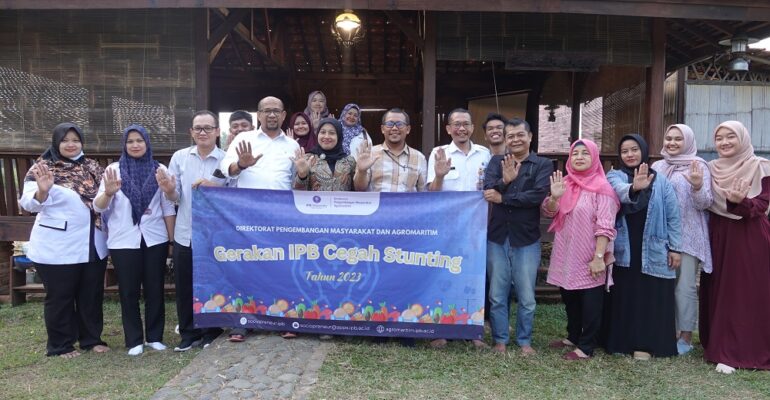DPMA Together with Fema IPB University Initiated the Formation of a Stunting Care Community in Balumbangjaya Village

The Directorate of Agromaritime Community Development (DPMA) together with the Faculty of Human Ecology (Fema) IPB University initiated the formation of a Stunting Care Community through the IPB Prevent Stunting (Gisting) Movement in Balumbangjaya Village, Bogor City, West Java Province. Taking place at Kebun Merdesa, DPMA, Fema IPB University and Balumbangjaya Village initiated a collaborative meeting to form a stunting caring community.
Gisting is a program that focuses on improving community welfare, especially in villages around the campus, through stunting prevention. Until now, stunting is still a national priority issue that must be followed up immediately to be alleviated. DPMA and Fema IPB University took part in concocting a village ecosystem model to prevent stunting, the ultimate goal of which is to reduce the prevalence of stunting in order to improve the quality of human resources (HR).
“IPB University as an academic institution has a role in educating and assisting the community for more holistic and integrated early prevention by involving the community as the main actor,” said the Assistant Director of PMA IPB University, Dr M Iqbal Irfany recently.
He said that the initiation of community formation was the result of discussions with experts from Fema IPB University who saw that the issue of stunting required the involvement of many parties. The Balumbangjaya sub-district was chosen based on the willingness of the village government to be open and have the same desire in responding to the stunting issue.
The experts from Fema IPB University who were involved were Dr Sofyan Sjaf (Dean of Fema, expert in rural sociology), Dr Tin Herawati (Chairperson of the Department of Family and Consumer Sciences (IKK), family science expert) and Reisi Nurdiani, SP, MSi (Lecturer in the Department of Community Nutrition). The community members from Balumbangjaya Village who also attended included R. Andrie Koesnandar, SSTP (Lurah Secretary), midwife, head of family welfare empowerment (PKK), posyandu cadres, and family planning field officers (PLKB).
Many direct (specific intervention) and indirect (sensitive intervention) factors influence the occurrence of stunting in children. “The availability of potential village data can provide potential studies related to consumption patterns, education, the economy and others so that further intervention can be based on appropriate needs,” said Dr Sofyan.
Dr Tin Herawati also presented the results of her research from various regions in Indonesia regarding stunting. “Each region has various causes of stunting. Not only about malnutrition or direct factors, but it can be more complex due to indirect factors such as the economy and education,” she said.
According to her, the handling of stunting for each case is different, so the right methods and targets are needed to make it more effective. “However, the main thing lies in the nutrition that is absorbed from consumption patterns,” said Dr Tin.
On that occasion, Reisi Nurdiani, MSi explained that stunting can be predicted before the baby is born. That is why prevention efforts are needed by preparing healthy and quality mothers from their teenage years.
“Thus, the major impacts of stunting such as the risk of metabolic disorders, decreased intelligence levels, economic losses due to low human resources and the threat of demographic bonuses can be minimized,” she explained.
In response to this, the Balumbangjaya Village welcomed IPB University’s assistance in forming a caring community. The hope is that this community can play an active, effective role and become a model for data-based stunting reduction and prevention programs. Community participation in the village community ecosystem model is expected to be applied in various regions. (*/Rz) (IAAS/Res)



